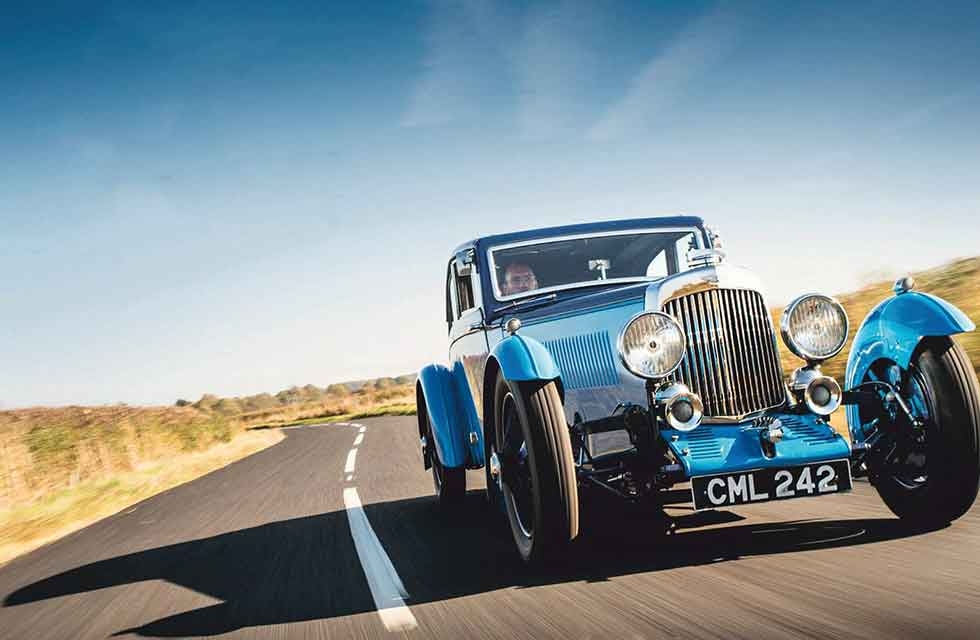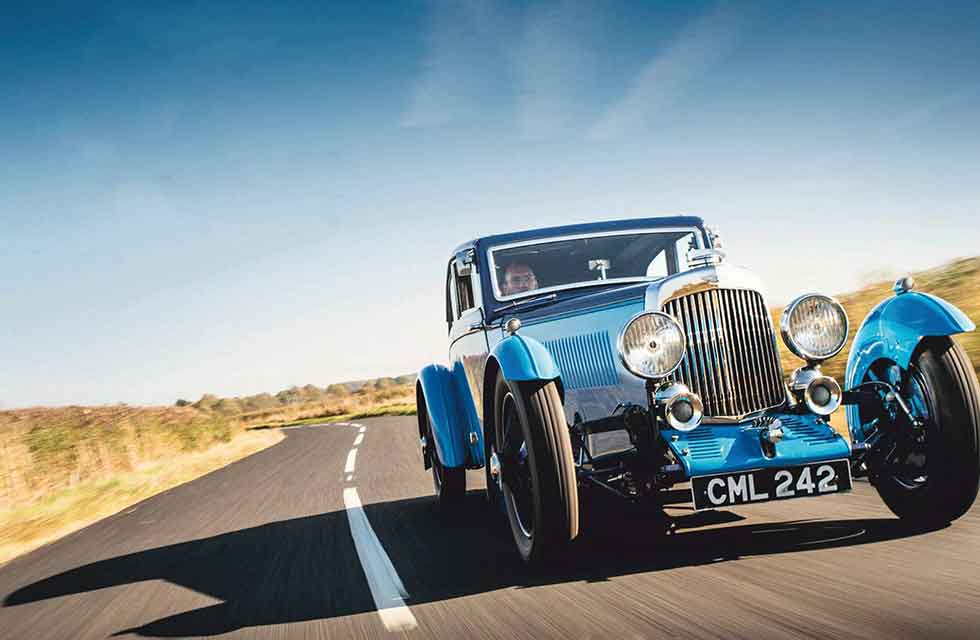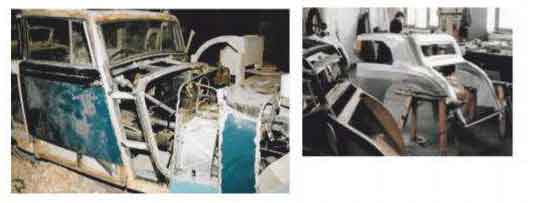
Inside the confusing, reined world of the 1934 Aston Special Sports Saloon. Speed With Style Exploring the history and road manners of a dashing Aston Martin MkII Special Sports Saloon. The Art Deco visuals may give the wrong impression of the Aston Martin MkII Sports Special Saloon. This is a focused tool, honed by the factory’s Le Mans exploits Words Rob Scorah. Photography Adam Shorrock.
SPEED WITH STYLE Aston Martin MkII Special Sports Saloon
I’m sort of realising how Alice must have felt; you know, she who went Through The Looking Glass to a world where things worked the other way around. I’m going pretty briskly, at the wheel of a 1934 Aston Martin MkII Special Sports Saloon, its guttural four-cylinder gruffly announcing every change in accelerator pressure. Glancing down at the controls, everything looks quite normal, but there are a few things to note if you are coming fresh from your paddleshift Vanquish.

The dainty-looking open-gate gearchange is the other way around – first is to the right, forward and hard by your knee. Amusingly, if you had the time to look, you’d see it says ‘TOP’ in capitals on the furthest away, down-to-the-left slot. There’s no synchromesh on this Moss ’box; all these cogs are manually meshed by you. That might not be so bad, but, until you’ve really got your pre-war head back on, there might be a momentary lag in responses. Remember, in these Astons, the accelerator is in the middle. And the brake is on the right.
And right now, I’m braking. It’s not the easiest pedal to locate, somehow a little behind the throttle and easy to hit at the same time as the gas pedal. I’m not talking in a heel-and-toe kind of way; lord knows how you would go on in a pair of Thirties brogues. But I’ve consciously remembered which one it is and I am in the process of braking. I know I’m braking hard because my right leg is pushing my backside into the back of the seat. And the effect? Well, the road’s going underneath the car just as fast as it was before, the little bright blue saloon undaunted by the unsighted right-hand hairpin we are approaching.
I’ve been in the car for around 20 minutes and, if you don’t drive Thirties machines too often, especially ones with the centre throttle, there’s always that initial warming-up period in which you have to manually override the habitual muscle memory of day-to-day driving. But, let’s be honest; that’s why we come here, to these cars – to get involved. To drive.
Astons were ever a driver’s car. When the MkII appeared on the scene in January 1934, motoring journalists of the time talked about its development from racing experience. Its predecessor had raced at Le Mans, the model acquiring that sobriquet along the way. At least one review announced the model as, ‘A fast sports car which inspires confidence’.
This model, the Special Sports Saloon, is essentially a MkII with a longer wheelbase. So I’m getting a very similar feeling from this car as that period road tester had experienced – the machine close around me, responsive, immediate controls. Chuckable. Though one probably needs to qualify those words.
Notice how knurled the steering wheel is; it’s a wheel that reaches virtually from your groin to your chin, brushing your thighs as you sit like Uncle Arthur on his deck chair on Brighton beach. The knobbly bits are for you to get your fingers meshed into, to really haul the little car about and bring it neatly into tight bends. The Aston will do this immediately, but remember that you are the power assistance in this car, so you will be calling on a fair few muscles plus the bracing of the bucket seat’s snug sides (and a tightened bum) to whip you round the turns. And on the subject of corners, there’s that hairpin coming up.
So far, we’ve been taking things fairly gently, going at a jaunty clip, but with not much effort. And probably not putting enough shove into the double-declutched jabs of the throttle, the cogs complaining with a croaking bark as metal teeth jostle to mesh. The unchallenging upchanges have been easy enough – just give a pause, a beat between each segment of the movement – but right at this moment, I could really do with coming down to second before hauling the MkII over to the left.
Later on, I’ll get it– that toe on the recessed brake and a quick kick with the heel to the accelerator as the left foot dances on the clutch (the whole thing is actually a much nicer action in a centre-throttle car). But right now, we’re staying in third, braking – I mean like actually slowing down, and turning.
Of the brake, the Aston turns clean and flat into the corner and, feeding the power back in, its poise is unruffled. I power out, another hairpin revealed ahead. This time I don’t go for second; third and the chassis held us exactly where we needed to be.
‘The Aston turns clean and flat into the corner and, feeding the power back in, its poise is unruffled’
Second would only have laboured the point, almost bogging the car down. It’s a simple case of a dab of the brakes, twist the wheel, power on – and breeze through the bend.
I’m sure, if we were better acquainted, it wouldn’t be long before we were playing with the merest touch of drift in the faster bends, but this isn’t the time or the place for that.
I have to admit, I’m slightly surprised at the car’s composure and tightness, although if I’d taken the time to read a bit more of the reviews of yore, I wouldn’t be. Everyone noted the MkII’s handling as excellent. The chassis was thicker and better braced than the previous model, with an additional crossmember behind the engine. And the front suspension had been modified, the Andre Hartford friction dampers now being transversely mounted, their outer ends mated to the wheel carriers. Steering sharpness and roadholding were both improved.
We’re swiftly out of the woods and going up the hill, my attitude to the Aston slightly changed. The more bold, or at least decisive I am with the controls (not ham-fisted), and the quicker I go, the easier and smoother it all becomes. A sharp shove on the throttle in the downshift sends the gearchange through with a seamlessness hardly matched by a double-clutched Porsche.
The gutsy motor picks up well from low revs. Well, I presume they’re low; the tachometer has been registering nothing more than total disinterest ever since I got in the car. But these are cars you drive more by feel and sound than by instruments. Thinking about the engine note, for all its hand-built nature the dry-sumped 1.5-litre doesn’t seem as snickety or ‘watch-like’ as I would have expected. It’s quite gruff in tone, though smooth in operation. The MkII’s counterbalanced crankshaft, uprated from the previous incarnation, running in three large bearings sees to that. Smoothness is something that was important to the model.
The Special Sports wasn’t, and isn’t, just for quick or hard driving, as the historical background to the model reveals. When, on the prompting of his son Gordon, Sir Arthur Sutherland had taken over the failing Aston Martin business in 1932, he was keen to see a return on his investment before sinking more money into former owner AC Bertelli’s ongoing racing programme. That return depended on selling more road cars, which led to the widening of the appeal of the models Aston built and the addition of a less hardcore two-plus-two tourer as well as the Sports Saloon.
Along with doing rallies or hillclimbs, the closed-bodied saloon was a car you could happily take mother to church in, or Audrey on a tour of the Highlands – without having to stop in every town you came to in order to buy her a new hat. Unlike many Aston Martins, it was, and is, a car you could be whimsical with. Have you ever tried being whimsical in a V8 Vantage?
Look again at that gorgeous coachwork with its hint of Art Deco in the long nose and low greenhouse. You might observe the hint of purposefulness in the lowered, narrowing and doubtless wind-cheating snout. But ignoring that and keeping the d’elegance theme going, notice instead the sunshine roof – a very fashionable item in the early Thirties. And every window opens. A great summer tourer. Sutherland’s insistence on refinements and developments paid of, because between January 1934 and December 1935, 166 MkIIs were sold. However, the Sport Saloon is something of a rarity, with only 22 ever being built.
This one, chassis number L4/524/L, did indeed take part in at least one motor sport event – the 1936 RAC Rally, in which it gained a second-class award with its first owner. Later it would pass into the collection of Aston Martin boss Victor Gauntlet before a period of relative neglect and finally, in 1991, restoration. It is a car of a type largely lost to us. It’s only when you get up close to the Special Sports that you realise just how small it is. It’s hard to find a present-day equivalent. Every modern sports saloon (usually German) isn’t far of the size of its full-fat counterpart, and still weighs as much as an airport ire tender. Their window pillars are as thick as this thing’s chassis rails. Maybe the Seventies Lotus Eclat/Elite approaches its compact nature, or possibly BMW’s Z3M coupe or even the Mazda RX8…
Even in-period there wasn’t a lot that came close. Of course, there was no shortage of handy, sporty models or formidable racing names producing road cars. MG, Sunbeam or Riley’s Nine which was doing rather well in the early Thirties, although in sport saloon ‘Kestrel’ guise, it looked a bit ungainly. As well as having the aesthetic edge, the aspiring Aston owner could feel a genuine connection with recent Le Mans cars; granted, more probably because, with limited development funds, the company had found it necessary to rely on less purely ‘race-developed’ models. The draw of individuality and exclusivity, then as now, would push buyers towards the Aston; it was almost all bespoke-made.
Or they might go higher, towards an Invicta, a Lagonda or a Bentley 3½ Litre. Or, for those who had seen the Teutonically dashing Hans Stuck von Villiez at Shelsley Walsh in 1936, maybe a Horch. Of course, if we’re wanting Art Deco, how about the Bugatti… OK, let’s leave it there. But, beautiful and powerful as all of those are, they are also bigger and heavier. All would be an absolute hoot racing Alison in the De Haviland across France, but on Cromarty, in the Peaks or the Malverns, or even ‘in town’, the little Aston is simply more fun.
Even today, it offers us a very complete package and, not least, the opportunity to really drive and take a significant part – for good or bad – in the whole mechanical process. Few cars can touch any pre-war machine for immersion in the experience. Then there’s the looks, of course, and the individuality.
Restoration costs for MkII Special Sport Saloons are such that project cars are often sacrificed to make open-topped Ulster replicas (28 originals were built), but for many a classic car fan, the saloon offers wider options. The rigours of wind-in-the-hair motoring are often times not even noticed by a driver, but passengers are a different matter. Cars like these are often as much enjoyed by non-car people – and even more enjoyed when shared. Alice, grab your gloves, let’s take a spin in that Special.
Thanks to Robert Blakemore and Ecurie Bertelli, where the car is for sale.
TECHNICAL DATA FILE SPECIFICATIONS 1934 Aston Martin MkII Special Sports Saloon
Engine 1493cc, inline four cylinder, sohc, twin SU H2 carburettors
Max Power 73bhp @ 5200rpm / DIN
Max Torque 129lb ft @ 2800rpm / DIN
Transmission Four-speed manual, rear-wheel drive
Steering Worm and nut
Suspension Front and rear: semi-elliptical leaf springs, Hartford friction dampers
Brakes Drums front and rear
Weight 457kg (1007lb)
Performance Top Speed: 85mph; 0-60mph; 24.8sec
Cost new UK 1934 £700
Price UK 2018/2019 £195,000
‘It’s only up close to the Special Sports that you realise just how small it is’
Light weight combined with responsive steering add up to a fun driving experience. The 1.5-litre four-cylinder engine gives surprisingly sprightly performance. Dash layout was revised for the MkII. Knurled steering wheel gives great leverage.
Rakish air of individuality is backed up by the fact that only 22 Sport Saloons were ever built. Special Sports Saloon’s longer wheelbase is graced by an elegantly elongated nose compared to the standard Aston MkII.
OWNING THE 1934 ASTON MARTIN MKII SPECIAL SPORTS SALOON
‘They’re a very expensive car to restore properly, so a lot are botched up,‘ explains Robert Blakemore, MD of pre-war Aston specialist Ecurie Bertelli. He adds, ‘Because the cost is so high compared to their overall value, you tend to get people chopping them up to make Ulster replicas.’
When, in 1991, a new owner finally handed over chassis number L4/524/L to Wakeield and Sons of Byleet, the car had already seen a lot of ad hoc repairs. The sliding roof had been plastered over.
‘It’s not unusual – if something like the sunroof leaks on one of these, you see a lot of quick fixes,’ laments Blakemore.
The once-opening windows were screwed into the bodywork and underbonnet supports had at some time been hacksawed short to give room for a gravity-fed fuel tank, the pump having presumably failed a long time in the past. Most worrying, on a structural level, the boot had been refashioned, bringing the spare wheel inside the car. Supporting timbers in the frame had been cut.

‘In the end, they decided it was cheaper to simply use a different body,’ Blakemore explains. Ironically, one had become available from a car that had itself been made into an Ulster replica.
The replacement body had all the correct fittings, including the external spare wheel, and was delivered to Wakeield’s to it. However, once stripped down, the new shell revealed its own collection of poorly executed repairs, so it was decided to retain only the wood frame and have new aluminium body panels made. While nearby G&A Fabrications set about fashioning the skins, Wakeield’s still had work to do on the frame – more amateur repairs to eradicate and (original builders’) inconsistencies side-to-side.
The work was made harder by the lack of patterned parts to work from. Fortunately, another MkII saloon owner allowed his car to be dismantled for the restorers to make patterns for the new parts.
In 1993 the car was completed and, running on a loan engine while its own was also being restored, the Aston completed a 2000-mile Canadian trek. While still fitted with its borrowed motor, the Special Sport won its class at the Pebble Beach Concours in 1997.








